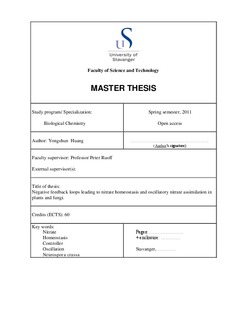| dc.description.abstract | Nitrate is an important nutrient for plants and fungi. For plants it has been shown that cytosolic nitrate levels are under homeostatic control. Here we describe two networks that can obtain robust, i.e. perturbation independent, homeostatic behavior in cytosolic nitrate concentration. One of the networks, a member in the family of outflow controllers, is based on a negative feedback loop containing a nitrate-induced activation of a controller molecule which removes nitrate. In plants this control structure appears to have at least two representations, one where the controller molecule is nitrate reductase removing nitrate for assimilation, while the other controller molecule takes part in the efflux of nitrate out of the cell. The second homeostatic network, a member in the family of inflow controllers, appears to be associated with the uptake of nitrate into the cell, the translocation of cytosolic nitrate into the vacuole for nitrate storage and the transport of nitrate from the vacuole into the cytosol. Interestingly, this control structure automatically adjusts the flux of nitrate uptake into the cytosol by the extent of how much cytosolic nitrate is removed. After the depletion of environmental nitrate, the vacuolar nitrate is sustained by the remobilization of vacuolar nitrate. In lower eukaryotes which lack nitrate storage in the vacuole and a nitrate efflux system, uptake of nitrate by such a controller depends therefore on the nitrate assimilation rate in the cell. Thus, practically no nitrate uptake should occur in lower eukaryotes when nitrate reductase is not functional, a behavior that was previously observed in fungi. Another interesting aspect is that outflow controller can oscillate and generate limit cycle oscillations in the assimilation of nitrate, thus making a link between circadian oscillations in nitrate assimilation and cytosolic nitrate homeostasis. | no_NO |
